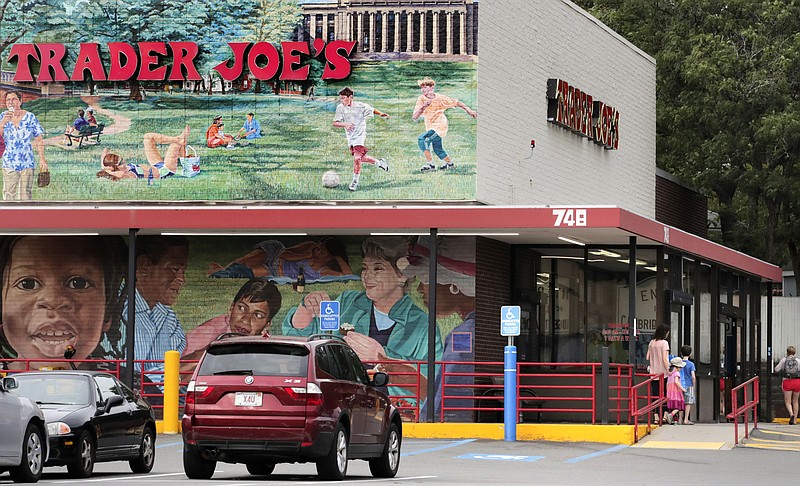Trader Joe's workers unionize supermarket
Employees at a Trader Joe's supermarket in Massachusetts on Thursday became the latest workers at a major company to approve a labor union.
The store in Hadley, about 80 miles west of Boston, is the first Trader Joe's with an employees union, although workers at two other company locations have initiated unionization efforts. The union vote, counted by National Labor Relations Board agents in front of witnesses from management and employees, passed 45-31 with one void. Eighty-one store workers - called crew members or merchants in company lingo - were eligible to vote.
"This victory is historic, but not a surprise,"a union tweet said. "Since the moment we announced our campaign, a majority of the crew have enthusiastically supported our union, and despite the company's best efforts to bust us, our majority has never wavered."
The company has seven days to file an objection. A company spokesperson did not indicate whether there would be one. The company already has among the best package of pay, benefits, and working conditions in the grocery store business, the spokesperson said.
Organizers at the store launched the effort in May in an open letter to company CEO Dan Bane citing concerns about pay, benefits and safety.
Apple profits dip despite sales gain
Apple's profit slipped during the past quarter, but the world's largest technology company fared better than many of its peers.
Despite manufacturing headaches and inflation pressures that have vexed a wide range of businesses, Apple profit declined by 10% while revenue edged up 2%. Both figures were better than analysts projected.
The results for the April-June period weren't a huge surprise. That's because Apple had already warned that its revenue would be depressed by as much as $8 billion because of supply chain problems that have been compounded by pandemic-related shutdowns in China factories that make iPhones and other Apple products.
Earnings fell to $19.4 billion, or $1.20 per share, while revenue edged up to nearly $83 billion.
As usual, Apple's results were propelled by the iPhone, which posted a 3% gain in sales from the same time last year.
Amazon sales up 7.3% as online growth slows
Amazon's growth continued to come down from its pandemic highs, the company said on Thursday, signaling a new normal as online shopping resets amid a tumultuous economy.
Amazon reported $121.2 billion in revenue in the three months ended June 30, up 7.2% from a year earlier. It was the company's slowest growth rate in more than two decades, down slightly from 7.3% growth the previous quarter.
Amazon lost $2 billion, down from a $7.8 billion profit a year earlier. The loss included a $3.9 billion decline in the market value of an investment in Rivian Automotive, an electric truck maker whose shares have fallen since going public last fall. The strong U.S. dollar also reduced sales by $3.6 billion, more than the company expected.
"Despite continued inflationary pressures in fuel, energy and transportation costs, we're making progress on the more controllable costs we referenced last quarter, particularly improving the productivity of our fulfillment network," Andy Jassy, Amazon's chief executive, said in a statement.
Amazon's growth looked particularly meager versus a strong second quarter last year, when growth surged 27%. At the time, vaccines were still in the early stages of distribution and federal stimulus checks buoyed consumer spending. The company's annual Prime Day deal event, which Morgan Stanley estimated generated $4.6 billion in revenue this year, was also held in the second quarter last year, but moved to the third quarter this year.
Facebook ends pay to news organizations
Meta Platforms says it will no longer pay U.S. news organizations to have their material appear in Facebook's News Tab as it reallocates resources in the face of the economic downturn and changing user behavior.
The company said Thursday that most of people "do not come to Facebook for news, and as a business, it doesn't make sense to over invest in areas that don't align with user preferences."
Meta, then called Facebook, launched the partnerships in 2019. The "News Tab" section in the Facebook mobile app only displays headlines - and nothing else - from The Wall Street Journal, The Washington Post, BuzzFeed News, Business Insider, NBC, USA Today and the Los Angeles Times, among others. The company did not say how much it was paying the news organizations, but reports put it in the millions of dollars for large outlets such as The Wall Street Journal.
Meta said in a statement Thursday that a "lot has changed since we signed deals three years ago to test bringing additional news links to Facebook News in the U.S."
- Compiled by Dave Flessner
